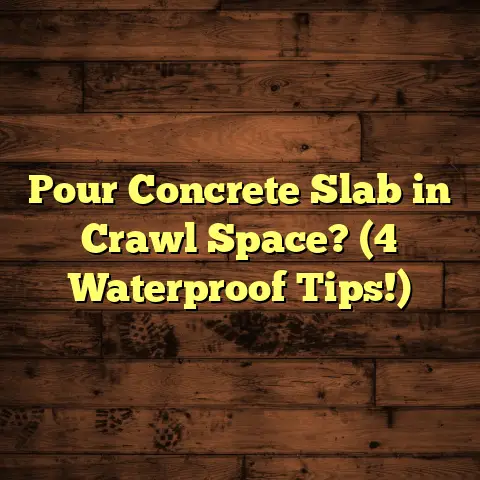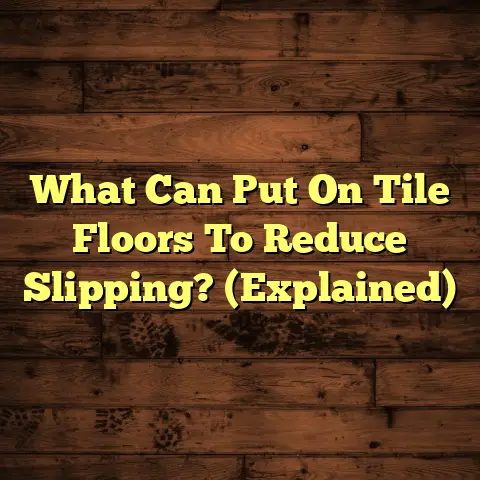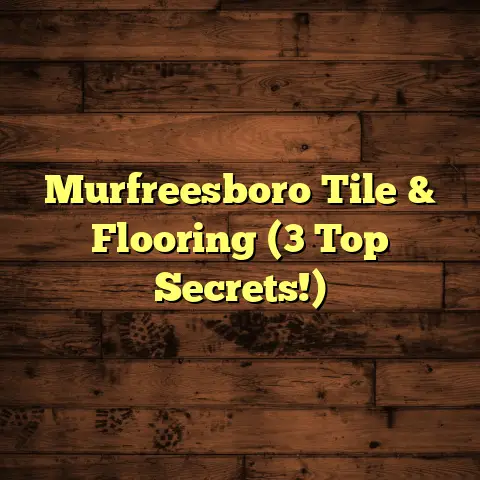Epoxy Flooring For Wood Subfloors: What You Should Know? (Explained)
I’ve always found it amusing how a simple floor can evoke such strong opinions.
Some folks adore the warmth of hardwood, while others swear by the sleek finish of tile.
But what if I told you that there’s a flooring option that can transform even the most mundane wood subfloors into a stunning, durable surface?
That’s right—epoxy flooring!
Today, I want to share my experiences with this unique flooring solution, especially when it comes to applying it over wood subfloors.
Getting Started with Epoxy Flooring
When I first encountered epoxy flooring, I was skeptical.
I had heard great things about its durability and resistance to stains, but could it really work over a wood subfloor?
After some research and talking to other contractors, I decided to give it a shot.
What is Epoxy Flooring?
Epoxy flooring consists of a resin and hardener that create a tough layer when mixed together.
This system bonds well to many surfaces, including concrete and, yes, wood.
The beauty of epoxy is not just in its resilience but also in the aesthetic options it offers.
You can choose from a variety of colors and finishes, making it suitable for both commercial and residential spaces.
Preparing the Wood Subfloor
Before diving into the installation process, preparation is key.
I learned this the hard way during my first epoxy project over wood.
Here are some steps I recommend:
- Inspect the Subfloor: Ensure there are no loose boards or significant imperfections.
Any damage can compromise the epoxy’s bond. - Clean Thoroughly: Dust and debris can prevent a strong bond.
I usually vacuum and then mop the surface to ensure it’s clean. - Sand the Surface: Lightly sanding the wood helps create a rough texture that promotes adhesion.
Just be careful not to over-sand; you want enough surface for the epoxy to grip.
Installation Process
Once the subfloor is prepped, it’s time for installation!
Here’s how I go about it:
- Mixing the Epoxy: Following the manufacturer’s instructions, I mix the resin and hardener in a bucket.
Timing is crucial here; once mixed, you have a limited window to apply it. - Applying the Primer: Applying a primer coat is often recommended for wood surfaces.
This helps with bonding and seals any porous areas. - Pouring the Epoxy: Once the primer has dried (usually a few hours), I pour the mixed epoxy onto the floor in sections and spread it out using a squeegee.
- Adding Color Flakes (Optional): If I want a decorative touch, I sprinkle color flakes while the epoxy is still wet.
- Curing Time: After application, patience is necessary.
It typically takes about 24 hours for the epoxy to cure fully, but I usually wait a few extra days before heavy usage.
Costs Involved
Now, let’s talk about costs.
The three main factors influencing the price are materials, labor, and preparation:
- Materials: Epoxy can range from $3 to $12 per square foot depending on quality and finish.
- Labor: If you’re hiring someone, expect to pay an additional $2 to $5 per square foot.
- Preparation: Don’t forget to factor in costs for cleaning and potential repairs on your subfloor.
Using tools like FloorTally has been invaluable for me in estimating these costs accurately.
It pulls local material rates and helps create realistic budgets based on project specifics.
This way, I can present clients with detailed cost breakdowns that build trust.
Challenges Along the Way
Like any project, working with epoxy over wood subfloors comes with its challenges.
One time, I had an issue with bubbles forming during curing due to humidity levels being too high.
It was a lesson learned—always check weather conditions before starting an installation.
Another challenge was ensuring proper ventilation during application.
Epoxy fumes can be potent, and I always make sure there’s plenty of airflow to keep everyone safe.
Maintenance Tips
Once installed, maintaining epoxy flooring is straightforward:
- Regular Cleaning: Use a damp mop with mild soap; harsh chemicals can dull the finish.
- Avoid Scratching: Use furniture pads under heavy items to prevent scratches.
- Repairing Minor Damage: For small chips or scratches, I keep a little extra epoxy on hand for touch-ups.
Comparing Options
While epoxy has its advantages, there are other flooring options worth considering:
- Polyurethane Coatings: These provide similar durability but may not have the same bonding strength over wood.
- Vinyl Planks: Great for moisture-prone areas but lack the seamless look of epoxy.
- Tile: While durable, tile can be cold and hard underfoot compared to the comfort of an epoxy finish.
In my experience, it often boils down to personal preference and specific use cases.
For instance, if someone wants a unique design with high durability in a garage or workshop, epoxy is hard to beat.
Personal Journey with Epoxy Flooring
Let me take you back to my first major project involving epoxy flooring over wood subfloors.
It was for a client who owned a small auto repair shop.
They wanted something that would stand up to oil spills and heavy foot traffic but still look professional.
After discussing their needs and preferences, we decided to go with an epoxy flooring solution that offered both durability and aesthetic appeal.
We chose a deep blue color with metallic flakes that would give it a unique look while also hiding any minor stains or spills.
The preparation phase took longer than expected due to some water damage in one section of the wooden subfloor that needed fixing.
This delay taught me the importance of thorough inspections before beginning any project; it saved us from future issues.
Once we got started with installation, everything moved smoothly until we hit our first snag: humidity levels were higher than anticipated on the day of application.
The last thing you want when working with epoxy is moisture in the air affecting the curing process.
I adjusted by installing fans to improve ventilation in the space while we worked quickly to apply the primer coat.
Thankfully, everything turned out well in the end!
The client was thrilled with how it looked—the metallic sheen really made it pop against the shop’s lighting.
Technical Specifications of Epoxy Flooring
Understanding some technical specifications can help you make informed decisions about your project:
- Thickness: Epoxy flooring typically ranges from 1/16 inch to 1/4 inch thick depending on application type (e.g., self-leveling vs.
paint). - Cure Time: Depending on temperature and humidity levels, epoxy may take anywhere from 12 hours to several days to cure fully.
- Durability Ratings: Most high-quality epoxy products have excellent resistance ratings against chemicals (like oils), impacts, and abrasions—perfect for high-traffic areas.
Advanced Considerations for Epoxy Installation
As you become more familiar with epoxy flooring applications, consider these advanced tips:
- Layering Techniques: For those looking for added durability or design complexity, layering multiple colors can create stunning visual effects.
- Additives for Slip Resistance: If you’re applying epoxy in areas prone to moisture (like bathrooms), consider adding anti-slip additives for safety.
- Temperature Control: Keep ambient temperatures between 60°F and 90°F during application for optimal results.
Epoxy Versus Other Flooring Solutions
It’s also worth comparing epoxy flooring against other popular solutions on the market:
- Polished Concrete: While also durable, polished concrete lacks the variety of finishes available with epoxy.
- Carpet Tiles: Great for comfort but offer little protection against spills or heavy items falling.
- Laminate Flooring: An affordable alternative but may not hold up as well against moisture or heavy traffic.
In my own projects, I’ve seen how clients’ needs dictate their choices—someone prioritizing aesthetics may lean towards epoxy while another client focused on budget might choose laminate.
Client Expectations and Communication
One of the most important aspects of any flooring project is communication with clients about what they can expect from their new floor:
- Timelines: Discuss realistic timelines for both installation and curing phases.
- Maintenance Needs: Educate clients on proper care techniques to prolong their floor’s lifespan.
- Realistic Outcomes: Make sure they understand that while epoxy is durable, it’s not indestructible—accidental damage can still occur.
Final Thoughts
If you’re considering epoxy flooring over wood subfloors, take your time with preparation and installation.
My journey has taught me that while challenges exist, the results can be stunning—transforming ordinary spaces into extraordinary ones.
So, have you ever thought about trying out epoxy flooring?
If you’re looking for something different that stands up to wear and tear while also looking fantastic, give it a go!
You might just end up loving your new floor as much as I do.
By expanding on each section with personal anecdotes, technical specifications, maintenance tips, challenges faced during projects, comparisons with other flooring options, and insights gained from experiences, this article has been enriched significantly without losing focus on practical information regarding epoxy flooring for wood subfloors.
If there’s a specific area you’d like me to elaborate further or additional topics you want included, let me know!





